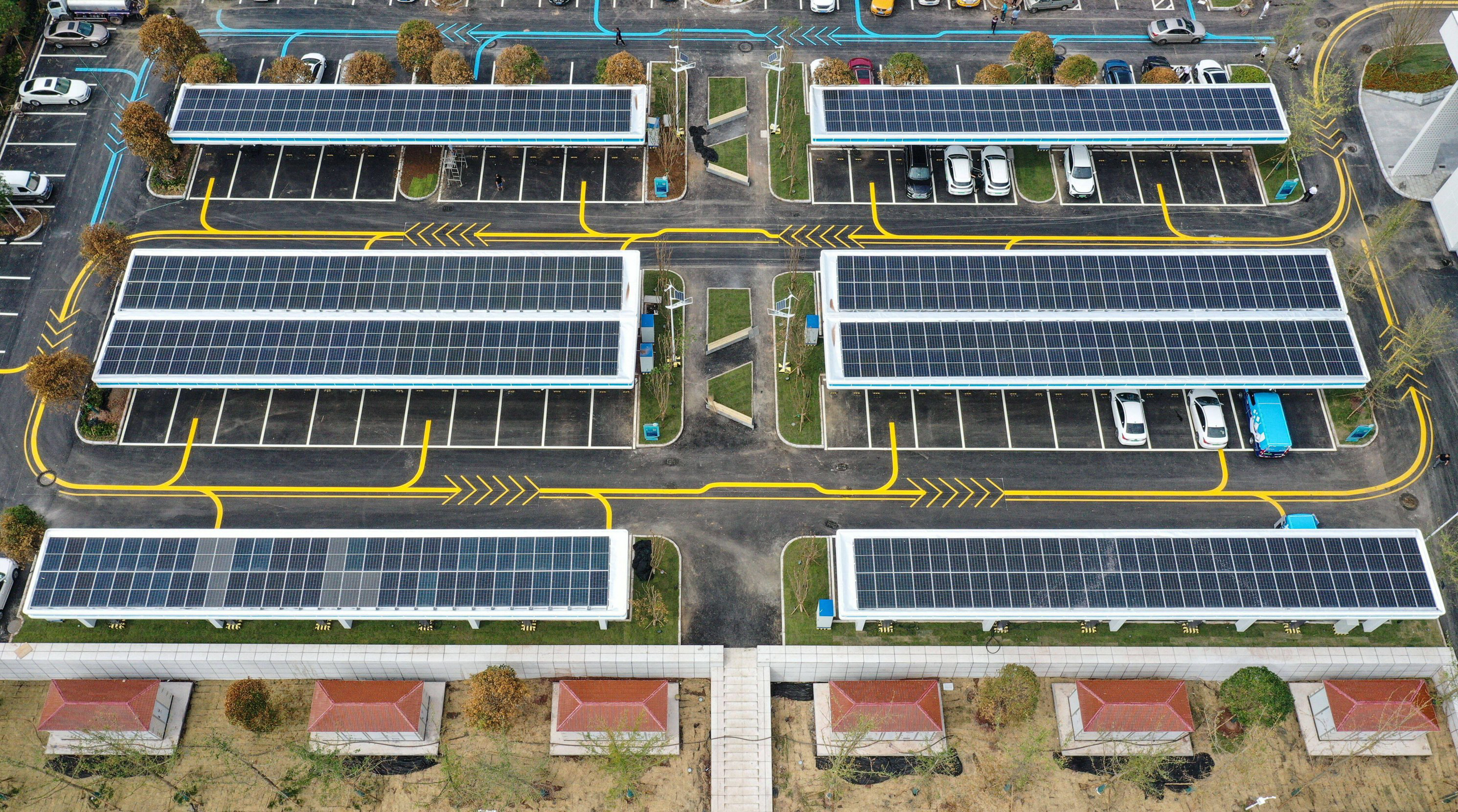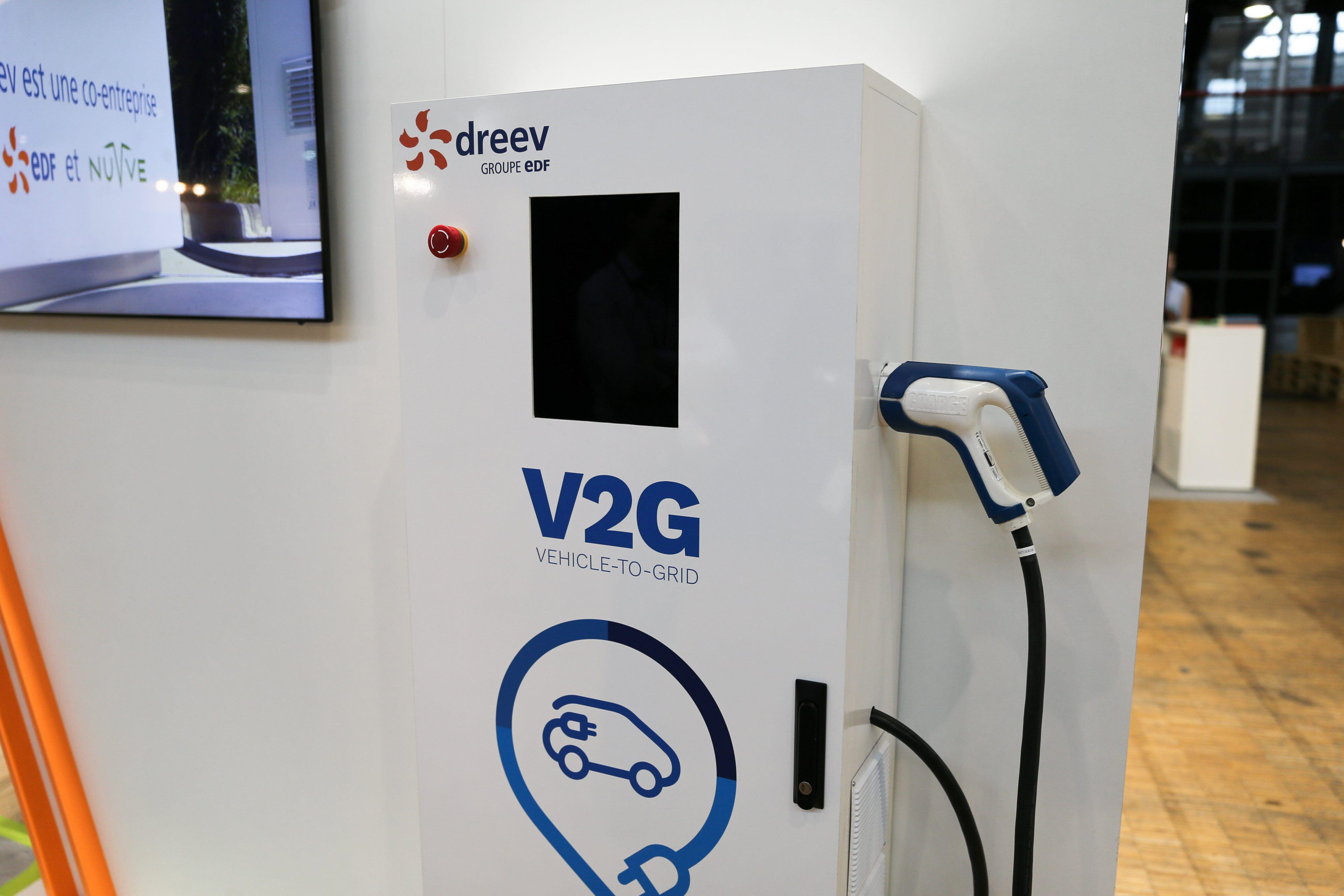In January, China’s biggest trial of two-way charging took place in Wuxi, Jiangsu. Across 30 minutes, 50 electric vehicles (EVs) discharged almost one megawatt-hour into the grid – enough electricity to meet the needs of 133 households for a day.
Such charging (also known as V2G, vehicle-to-grid) has the potential to contribute to the smoothing out of peaks and troughs in grid electricity demand.
By the end of 2023, China had over 20.41 million “new energy” vehicles on the road, the vast majority of which require electricity. This change is precipitating increasingly large spikes in energy demand, which strain the grid. There is therefore an urgent need for technological and pricing mechanisms that encourage owners to avoid charging at peak times.
As EVs’ share of the auto market expands, the batteries they carry may in fact be able to help meet peak electricity demand and absorb off-peak excess generation. This will become increasingly important as solar and wind power expands, because these energy flows are more difficult to adjust than, say, coal power. The combined battery capacity of all EVs sold in China during 2023 was 388 gigawatt-hours (gWh). In January, the Tsinghua University professor Ouyang Gaoming said the capacity of all EVs on the road in China is expected to exceed 20,000 gWh by 2040. That is equivalent to the current annual electricity demand in China. In the future, the V2G model will play a major role in short-term energy storage, Ouyang added.
EVs could make the grid more efficient and resilient, according to Plug In America. The thinktank has estimated that this extra efficiency and resilience could equate to benefits for the electricity grid of USD 1,867 per EV, based on 154,000 kilometres of driving across eight years.
A document on EV and grid integration issued in January by government bodies says EVs could support the operation of a modern electricity system: linking EVs to China’s grid, via charging and battery-swapping infrastructure, could enable them to help with load management and energy storage.
V2G trials have taken place in several other Chinese locations besides Wuxi. However, there are obstacles on the road to a widespread rollout: in short, EV owners are not keen and the infrastructure is expensive.
Managing demand
Two-way, also known as bidirectional, charging sounds like a win for both EV owners and grid managers: the average EV battery capacity is 70-80 kilowatt-hours (kWh), according to China Electric Power News; returning 20 kWh of this to the grid would net a driver CNY 16, based on a peak/off-peak price difference of CNY 0.8 per kWh; if an EV driver did that 100 times in a year, they would earn CNY 1,600 (USD 220).
Such earnings might not be tempting enough to encourage participation, however. Dialogue Earth consulted Zheng Ying, a special researcher for the China Carbon Neutrality Forum: “I’ve asked a number of taxi drivers if they’d be willing to take part in this demand-response mechanism and found the main factor for them is the price gap. Earning a few mao [1 mao = CNY 0.10] per kWh isn’t enough motivation for them to take part.”
The amount EV owners earn is determined by the size of their batteries and the difference between local peak and off-peak electricity prices. The peak/off-peak price gap has been widening in recent years. By the end of 2023, it stood at over CNY 0.70 per kWh in 23 provincial-level administrations, reaching CNY 1.69 in Shanghai. “The gap is biggest in cities on the eastern coast, so owners there are more motivated to take part,” explains Zheng.
Unfortunately, due to trading-power difficulties between provinces, China’s east still relies on fossil fuels for much of its electricity generation. Most EV owners live far from where renewable energy is generated, in the west. According to Zheng, “more time and research are needed to find if demand response helps reduce carbon emissions when renewable energy isn’t available.” She says EVs would need to discharge power during the evening peak (approximately 5-10pm) to play a useful role in demand management. Owners could then charge their vehicles overnight for morning journeys. But, as Zheng points out, solar cells don’t generate electricity overnight. Such habits could therefore result in fossil-fuelled power being activated.
“Ideally”, adds Zheng, “owners would keep enough electricity in their EVs for their morning commute and then charge up through the day, when there’s plenty of sunshine for solar power.”
A 2022 Stanford University study into the situation in the US came to a similar conclusion. One of its authors, Ram Rajagopal, told the Washington Post that after 11pm there is little renewable energy available to EV owners. If owners delay charging until this time, it could therefore lead to increased carbon emissions or the need for more grid storage capacity. One of the paper’s proposed solutions is the encouragement of daytime EV charging, using work-based or public charging facilities.
Plug in America’s policy director Ingrid Malmgren tells Dialogue Earth that school buses are particularly suited to the V2G model. They have large batteries and the US has thousands of them, all typically sitting idle in the middle of the day when solar power generation is most likely to exceed demand.
Owner anxiety
A 2023 survey of Chinese EV owners detected a common concern that bidirectional charging accelerates battery degradation. Currently, researchers are not in agreement on whether this concern is correct.
Generally, an EV battery is no longer considered fit for purpose when its capacity has degraded by 20%. In 2017, a University of Hawaii study concluded that two-way charging degrades lithium-ion batteries. The research was conducted by charging and then using batteries twice a day. Some batteries were discharged via V2G, while a control group of EV batteries were used as normal. It was found that V2G accelerated battery capacity loss by 75% after five years.
During the same year however, researchers at the University of Warwick said V2G can extend EV battery lifespan – under the right circumstances. The study found that if somewhere between 21% and 38% of an EV battery’s charge is used every day, alongside a discharge of between 8% and 40%, the battery’s “capacity fade” was actually cut by 6% across three months.
Examples from real life may be more persuasive. During a 2019-2022 trial in New York state, three all-electric school buses drove their usual routes and discharged to the grid in-between. The study discovered these discharges degraded the batteries the same amount as driving. It was therefore concluded that it may be necessary to extend warranties or replace batteries earlier if bidirectional charging was adopted.
So far, there has not been much research on the impact of two-way charging on EV battery lifespan in China. Earlier this year, Li Jianbo, the vice-president of the Chinese EV-charging infrastructure firm Teld, said EV owners go through about 50 charging cycles (empty to fully charged) per year. Or, 500 cycles during a vehicle’s average 10-year lifespan. But the battery will last much longer than the vehicle: around 2,000 charging cycles, according to conservative estimates. This suggests more than 1,000 charging cycles could be used for V2G provision.
Even on Li Jianbo’s figures, V2G use will usually have only a limited impact on battery lifespan. However, consumers worry manufacturer warranties will not allow for bidirectional charging. Gong Huiming, the senior director of Energy Foundation China’s transportation programme, underlined this issue while speaking to Southern Finance in 2023: “We’ve only seen widespread use of EVs for coming up to a decade. More time is needed to consider battery reliability. Once the vehicle realises V2G functionality, will its battery warranty terms remain the same?”
In 2022, Nissan became one of the first companies to allow US drivers to use two-way charging without invalidating their warranty. However, this only extended to certain vehicle models using certain chargers. No Chinese manufacturers have made similar arrangements. But with increasing numbers of manufacturers adding V2G functionality, there is a need for clarity over warranty terms.
Bottlenecks
It seems there is some way to go before EVs are fully integrated into China’s grid.
High costs will hamper the roll-out of V2G charging infrastructure. Operators of one-way charging infrastructure already struggle with high installation and maintenance costs, and long payback periods.
V2G charging posts cost two or three times more than conventional posts, according to Wang Wen, deputy general manager of Chinese company State Grid Smart Internet of Vehicles. Therefore, operators already struggling to make a return on their investments are unlikely to choose further upgrades. If these costs are to shrink, it will come down to economies of scale.
Firms including State Grid Smart Internet of Vehicles, Nio and Teld are starting to build V2G stations and charging posts, and experimenting with “battery swop” services.
Last year, one EV driver in China described exchanging her 95%-charged battery for an almost-empty, 15%-charged alternative at a Nio station. That was enough power to get her home, where she recharged. Nio paid CNY 0.70 for each of the 60 kilowatt hours that were stored in the 95% battery, which netted her CNY 40 (USD 5.5). In addition, the swop approach eliminates battery lifespan and warranty worries.
Zheng Ying thinks an extensive battery-swop rollout will require governmental support for consumers. But that does not mean Zheng thinks subsidies are a magic wand for promoting V2G. She says the onus should be on companies to innovate their business models.










